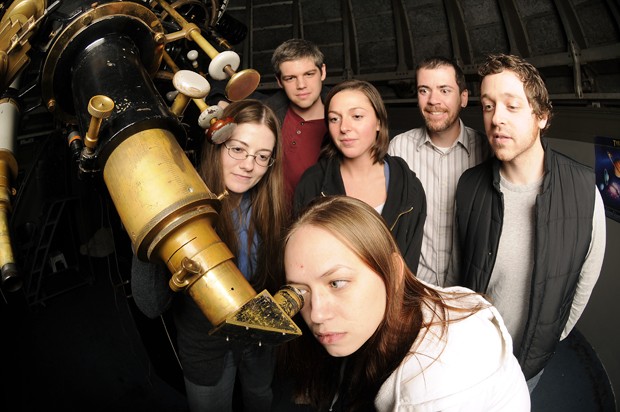Celebrating the International Year of Astronomy and the 400th anniversary of GalileoâÄôs use of the telescope , the physics and astronomy departments are holding public astronomy observations Friday evenings on the roof of Tate Laboratory. Susana Deustua, committee co-chairwoman of the International Year of Astronomy in the U.S., said Galileo pioneered the field by being open to technology and innovation. âÄúIf heâÄôd had a bumper sticker âÄî if heâÄôd had a bumper âÄî he would have had a sticker that said âÄòQuestion authority,âÄùâÄô Deustua, said. Associate professor of astronomy Liliya Williams said the invention of the telescope was the birth of modern astronomy. âÄúItâÄôs allowed us a much deeper view of the universe compared to what we can see with the naked eye,âÄù she said. Galileo used the first telescope in 1610 to observe sunspots, the Milky Way , and to discover and map the four largest moons of Jupiter. University of Minnesota graduate student and teaching assistant Jennifer Delgado said Galileo used the past to make new discoveries. âÄúThere were predecessors, things he did on the shoulders of giants,âÄù she said. âÄúHe just clarified what was going on in our solar system.âÄù In 2007, the United Nations approved the International Astronomical Union resolution, making it an international event, aimed at increasing public knowledge of astronomy sciences. Deustua said an approval from the UN General Assembly was needed to make the year international. To raises awareness of light pollution, the theme of this weekâÄôs public night is Dark Skies. âÄúIf you live in a city, you canâÄôt go outside and see the sky the way your grandparents would have seen it,âÄù Deustua said. âÄúThatâÄôs only a few generations ago. You lose an appreciation of the night sky.âÄù Stargazing is not new on campus. Five years ago, John Martin, former University student and current associate professor of astronomy and physics at the University of Illinois, restored and refurbished an antique telescope as part of his post-doctorial studies. The telescope was built in the late 1890s, and was originally housed in an observatory by the Mississippi River before it was moved to Tate Laboratory roof. Delgado said the various people who attend the evenings âÄî ranging from families with small children to students and older couples âÄî provide questions âÄúfrom all over the board.âÄù But Williams said science still does not have the answers to some stargazersâÄô questions. âÄúThe answers may answer the questions specifically or it may say wait another 10 years, and hopefully weâÄôll have the answer,âÄù she said. The 137 countries participating in the International Year of Astronomy include the U.S., Canada, Mexico, Great Britain, Iraq, Kenya and Australia. To verify a stargazing will be held, call 612-626-0034 an hour before the scheduled start time.
Gaze deeply into my skies
University departments celebrate year of astronomy with stargazing on the Tate roof.

Image by Chris Roberts
Astrophysics senior Tessa Vernstrom peers into the hundred year old telescope in Tate hall as other astrophysics graduate and undergraduate students look on. In honor of the international year of astronomy there will be public viewings at the telescope every Friday night.
Published March 26, 2009










